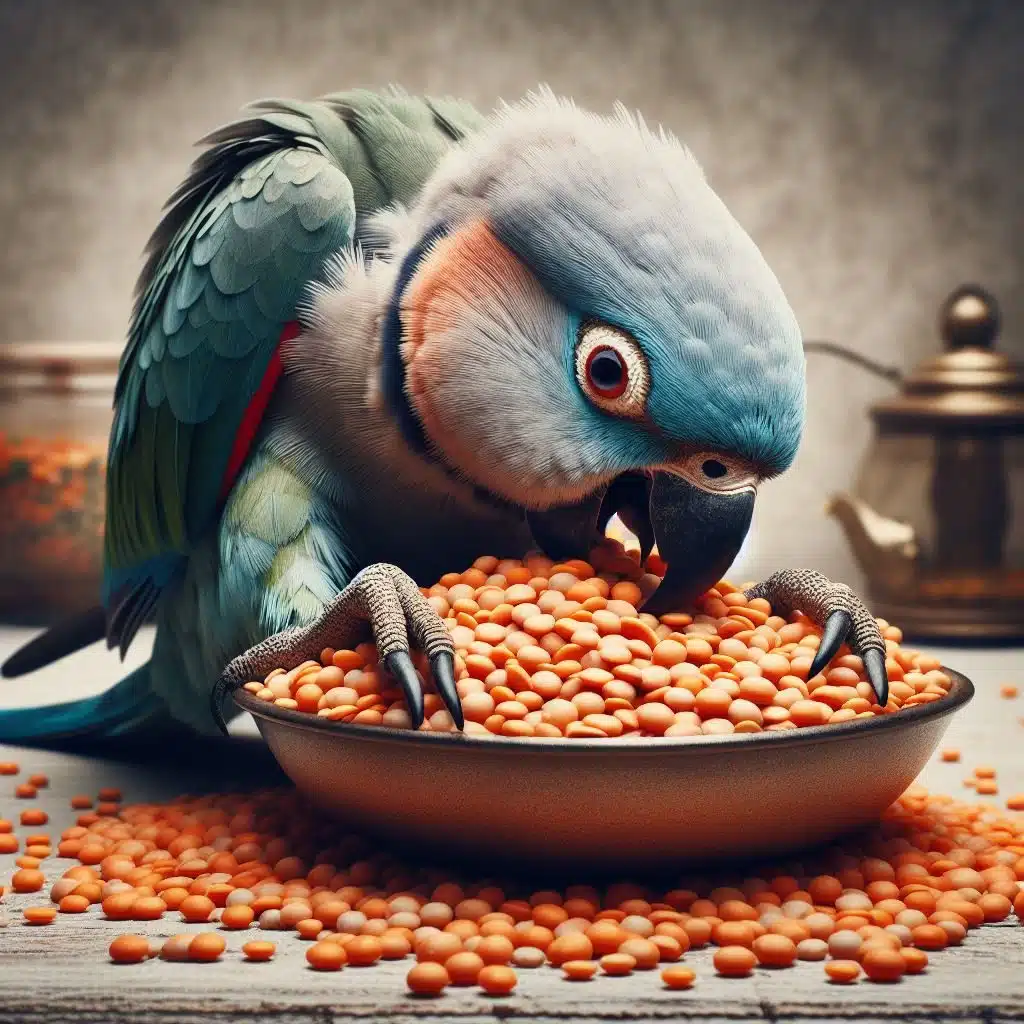A parrot’s diet is critical to them and what you feed them will determine the quality of life they have. Their diet should mainly consist of fresh fruit and vegetables, pellets, and seeds. With the odd treat being given every so often as we humans like to.
You want these foods to be organic which usually means better nutrition. An example is lentils, an edible seed from the legume family. They are a very common food in Turkey, Tunisia, Syria and now Canada are the greatest producers of lentils nowadays.

So can parrots eat lentils? Yes, parrots can eat lentils they are safe for them and also provide great nutritional value for our feathered friends with quality vitamins and nutrients being densely packed inside the small legumes. Lentils provide parrots with iron, vitamin B6, fiber, folate, and magnesium. You should consider making lentils an addition to your bird’s diet, although they shouldn’t be treated as a staple.
In this article, I’ll explain the benefits of lentils, the different kinds, and other things you need to know so read on!
Lentils Benefits For Parrots
We know lentils are good for our Parrots, but just how good are they? Let’s take a closer look at the nutritional content.
A 100g serving of green/brown lentils (boiled) contains:
| Calories | 105 |
| Protein | 8.8 |
| Carbs | 16.9g |
| Fat | 0.7g |
| Fiber | 5.1g |
Fiber
Lentils contain a lot of fiber which is great for helping your parrot with constipation and improving bowel health.
It does this by increasing the size and weight of your parrot’s stools, which leads to an easier passage through their digestive system.
Fiber also acts as a weight maintainer, this is due to foods high in fiber being very satiating – meaning more filling than other foods that don’t contain fiber. This will stop your parrot from overeating and becoming fat as they won’t be as hungry.
Iron
Iron supports many bodily functions like improved energy and focus, improved immune system, and gastrointestinal processes. The benefits of iron tend to go unnoticed until your parrot receives a lack of it. So be sure to make sure there is enough iron within your bird’s diet.
Vitamin B6
Vitamin B6 is a vitamin that’s in charge of regulating metabolism along with the central nervous system. It converts food into energy and helps to create feel-good receptors like dopamine and serotonin. These two things are the things that make you happy so vitamin B6 can actually fight against depression or anxiety in parrots.
Other sources of vitamin B6 include potatoes, bananas, and nuts.
Folate
Folate is useful for helping the body make healthy red blood cells.
Magnesium
Lentils also contain some magnesium, which is important for many of the body’s functions. Magnesium helps with blood pressure, cardiovascular health, and keeping bones strong.
It’s also known to reduce inflammation. Foods high in magnesium include kale, spinach, and cashew nuts.
Types Of Lentils
Brown: These are the most common lentils that are consumed, they’ve got a very earthy flavor and hold shape well while being cooked.
Puy: They come from the French are Le Puy (hence the name). They’ve got a more peppery taste to them and are smaller in size.
Yellow & Red: These lentils pack a very sweet and nutty flavor, during cooking they split apart very quickly which tends to make them cook a lot quicker.
Green: Green lentils vary in size and are a cheaper alternative for recipes that require Puy lentils.
How You Should Feed Lentils To Your Parrot
If you’re going to give your parrot a taste of some lentils it’s not advised you do so raw. This is due to the presence of anti-nutrients like tannins and phytic acid. Which will do the opposite of giving your parrot the sought-after nutrition.
Before cooking lentils you want to give them a quick rinse to remove any impurities. After they are cleaned the cooking process is really simple and can be ready in under 30 minutes, unlike some other legumes that require soaking before being cooked.
After that, you can put them in a pot with some water and a pinch of salt, bring to a boil, and then leave them to simmer uncovered for 20–30 minutes. You’ll know they are ready when they have a soft crunchy texture to them.
All that’s left is for your feathered friend to enjoy them!
What Other Foods Can Your Parrot Eat?
You know lentils are safe for your Parrot to eat but if you’re like me then you’re always looking for new foods to improve your Parrot diet to create some variety and include vital things that aren’t already in your bird’s diet.
So what other foods can your Parrot eat?
- Fruit & Vegetables
Foods like asparagus, broccoli, carrots, peppers, bananas, blueberries, and pineapples are all fine and encouraged for your Parrot to eat.
- Nuts
Things like almonds, Brazil nuts, cashews, hazelnuts, pistachios, and walnuts can be fed to your parrot. Just be wary of the fat content in some of them so they may need to be treated as a snack for your Parrot. We don’t want them getting fat!
Frequently Asked Questions
Can Parrots Eat Raw Lentils?
It’s not advised to feed parrots raw lentils as they will contain anti-nutrients unless they are cooked. Anti-nutrients block or interfere with how your bird’s body absorbs other nutrients. Meaning they are going to miss out on some benefits that other foods are trying to give them.
Lentils For Parrots – Final Thoughts
Lentils, when cooked are completely safe for your parrot to have. For such a small food there are dozens of vitamins and nutrients packed inside them which makes lentils a great addition to your parrots diet.






